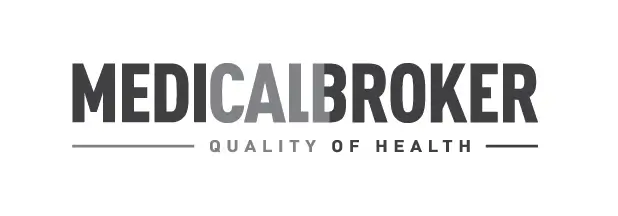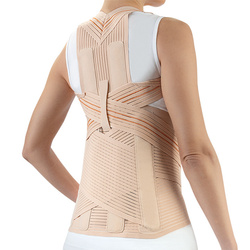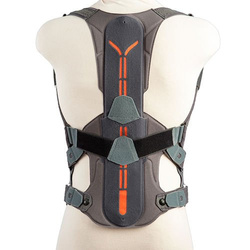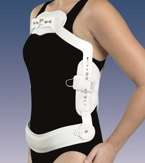TLSO back braces
( number of products: 35 )Back braces and their uses
Choosing a back brace requires an in depth consultation with you doctor or physiotherapist, as each model serves its own purpose. Read on to learn which one would be best-suited for treating your specific condition.
Back braces - who are they for?
Back braces are professional medical products that are designed to treat certain conditions that affect the back. Note that you should first consult with a doctor or physiotherapist before purchasing this product, as the right model needs to be chosen, either for treating your specific condition, or to be used prophylactically.
A back brace is usually recommended for people who are experiencing back problems resulting from osteoporosis or rheumatism, as well as those who have postural defects, such as pectoral distortion of the spine segment. Other common defects may include kyphosis and secondary kyphosis as well. There is also a back brace for scoliosis, designed for correcting posture in children in the case of scoliosis.
In some cases, even a tlso back brace may be recommended after a patient has undergone surgery in either the thoracic, lumbar and sacrum part of the spine. Certain models are also used in treating injuries, especially fractures and compression injuries of the spine, and may also be recommended for treating chronic muscle pain or inflammation of the facet joints which is common around the chest area.
How do orthopedic back braces work?
A back brace is designed to stabilize a specific area of the spine, however, certain injuries can affect a number of spinal segments. For treating these types of cases, a TLSO back brace is recommended. Other back conditions caused by osteoporosis or scoliosis require specific braces for treatment - such as a back brace for osteoporosis. Overall, each back brace is designed to relieve the vertebrae of built up pressure and to reduce further injury to the spin and spinal cord.
A back brace for posture can help the wearer to regain balance when walking, while preventing further injury and reducing pain. More stiffened models are designed to protect postsurgical wounds from reopening and help to relieve the operated portion of the spine, in order to speed up tissue regeneration in the area. Most back braces help the wearer regain proper posture, as well as physiological positioning of the chest and other parts of the torso.
How to choose the right back brace?
Each back brace available in our catalogue is a professional medical product, therefore it should be used as recommended by your doctor or physiotherapist. Every model is designed to help treat a different condition affecting the back and are made to adapt to the wearer’s physique. Our back braces are certified, which confirms their quality and that they are professional-grade medical products.
The back braces in our catalogue are made of durable and comfortable materials. Internal support rails are secured in a way that provide stabilization of the spine without causing skin abrasions. Many models, such as the TLSO back brace, are designed to keep moisture from building up and prevents bacterial development - all while keeping you comfortable.
What back brace you choose depends solely on the condition of your spine. In the case of osteoporotic symptoms, a more lightweight brace with self-locking buckles is recommended, such as the BORT Dynamic FX Active back brace. As for a more discrete model that is meant to treat rheumatic conditions as well as lumbar and sacral back pain, the Otto Bock Dorso Direxa Posture 50R59 back brace is an ideal choice - as it was made of breathable materials and is stiffened with an elastic brace.

FJ208 Lumback Fresh dorso-lumbar orthosis

FJ209 Lumback Fresh dorso-lumbar orthosis

Orliman adaptable dorsolumbar module to evotec back support

Orliman Jewett brace with three-dimensional sternal adjustment
- 1
- 2
















